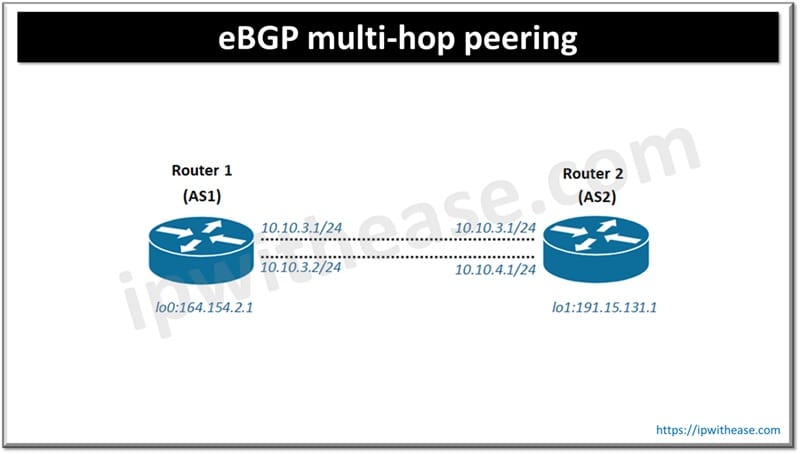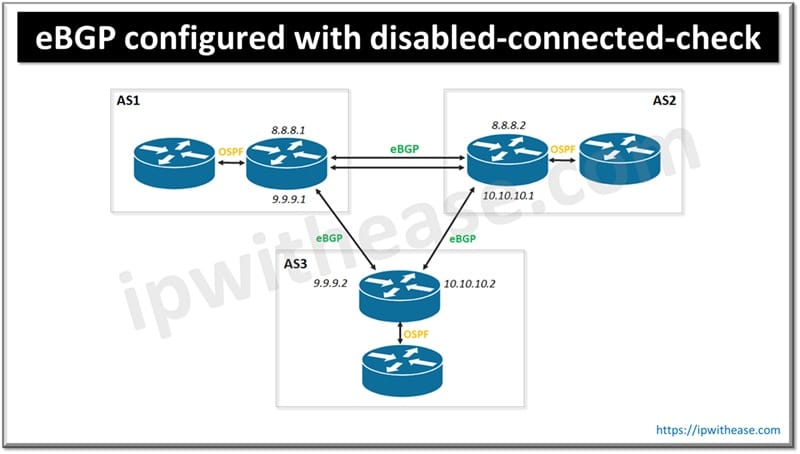Table of Contents
BGP can operate in multi-hop mode or disable-connected-check mode. If you do not want to use BGP Multi-hop for peering then the disable-connected-check command can be applied to enable peer relationship between two directly connected routers using their loopback addresses.
The OSI model uses a variety of protocols at each layer of its layer to enable communication of data from source to target systems. At the networking layer several routing protocols operate to handle the routing requirements of data packet transfers. BGP (Border gateway protocol) is a popular routing protocol which is widely used in Wide area networks (WAN) to establish peer-to-peer communication between network domains. It is used to exchange information among routers in different autonomous systems (AS).
In today’s article we will understand how BGP works in multi-hop or disable-connected-check mode and what are the characteristics and purpose of each command and resulting configuration.
What is BGP multi-hop
BGP multi-hops allows creation of connection between peers even if they are not directly connected and separated by one or more intermediary routers. The Time to live (TTL) value is increased in the BGP packet header to achieve this which determines the maximum number of hops a data packet can traverse before being declared discarded.

In above figure 1: router 1 belongs to AS1 and router 2 belongs to AS2. The two-physical links between AS1 and AS2 are meant for load balancing. The eBGP peering works well on a single physical interface.
Configuration
Let’s look at the typical configuration required here.
[edit protocols bgp group ext-peers]
type external;
local-address 164.154.2.1;
neighbor 191.15.131.1 {
multihop ttl 1;
}
[edit routing-options]
static {
route 191.15.131.1 next-hop (10.10.3.1 | 10.10.4.1);
}Use Cases for BGP multi-hop
- When eBGP peers are not connected directly but reachable via other routers and must cross one or more non-BGP routers to reach each other
- BGP sessions maintenance even if one link fails between peers for redundancy
- Used in loopback peering scenario for eBGP peering which might be more than one hop away
- When network routing device need to run e-BGP with third party router that do not allow direct connection between two eBGP peers
What is disabled-connected-check
Disabled-connected-check command enables peering between two directly connected routers without using eBGP multi-hop. eBGP messages are delivered with Time to live (TTL) value of 1 if it is not configured to modify the default TTL value. Routers configured with eBGP multi-hop enabled will treat neighbors in implicit manner as if the disabled-connected-check is configured or we can say in other words eBGP multi-hop disables connected-check configuration. When TTL or eBGP multi-hop is configured with 2 or more hops then the disabled-connected-check command is ignored. For already activated disabled-connect-check no separate configuration is required to be done.

Configuration
Let’s look at typical configuration required here
router bgp 1
neighbor 8.8.8.2 remote-as 2
neighbor 8.8.8.2 update-source loopback 0
neighbor 8.8.8.2 disable-connected-check
!
ip route 8.8.8.2 255.255.255.255 s0/0
ip route 10.10.10.2 255.255.255.255 s1/0
!Use Cases for BGP disabled-connected-check
- Allow peering session between eBGP peers not connected directly but reachable via single hop (loopback address)
- Peering between loopback addresses
- Peering redundancy required over multiple interfaces without the need to use physical links in multi-hop kind of configuration
Comparison: BGP Multi-hop vs disable-connected-check
| Parameter | BGP multi-hop | disable-connected-check |
|---|---|---|
| Purpose | Allow peering between routers which are not directly connected | Allow peering session between eBGP peers not directly connected but reachable by single hop |
| Function | BGP packets traversing over multiple hops | BGP peering redundancy using loopback addresses |
| Features | * Connecting multiple sites within an enterprise networks in cost effective manner * Increased scalability and reliability * Improved redundancy * Protection from external threats using authentication and encryption protocols * Establish eBGP sessions across different geo locations | * Help in setting up redundant BGP peering’s * Provides flexible and redundant connectivity * Simplified configuration * Provides redundancy if physical link fails BGP sessions still remain active over loopback addresses |
Download the comparison table: BGP Multi-hop vs disable-connected-check
ABOUT THE AUTHOR

You can learn more about her on her linkedin profile – Rashmi Bhardwaj



